
Flagler County is a county located in the northeastern portion of the U.S. state of Florida. As of the 2020 census, the population was 115,378. Its county seat is Bunnell, and the largest city is Palm Coast. Created in 1917 from portions of Saint Johns and Volusia Counties, it was named for Henry Flagler, who built the Florida East Coast Railway.
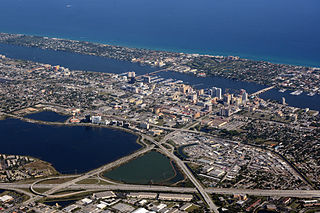
Palm Beach County is a county in the southeastern part of Florida, located in the Miami metropolitan area. It is Florida's third-most populous county after Miami-Dade County and Broward County and the 26th-most populous in the United States, with 1,492,191 residents as of the 2020 census. Its county seat and largest city is West Palm Beach, which had a population of 117,415 as of 2020. Named after one of its oldest settlements, Palm Beach, the county was established in 1909, after being split from Miami-Dade County. The county's modern-day boundaries were established in 1963.

Boynton Beach is a city in Palm Beach County, Florida, United States. It is situated about 57 miles (92 km) north of Miami. The 2020 census recorded a population of 80,380. Boynton Beach is located in the Miami metropolitan area, which was home to 6,138,333 people at the 2020 census. The city is named after Nathan Boynton, a Civil War major and Michigan politician who became one of the first settlers in the area in 1895. Boynton Beach is located north of Delray Beach, south of Hypoluxo and Lantana, and east of Golf, while the municipalities of Briny Breezes, Gulf Stream, Manalapan, and Ocean Ridge are situated to the east across the Intracoastal Waterway.

Lake Clarke Shores is a town in Palm Beach County, Florida, United States. The town is part of the Miami metropolitan area of South Florida. The 2020 census recorded a population of 3,564.

Lake Worth Beach, previously named Lake Worth, is a city in east-central Palm Beach County, Florida, United States, located about 63 miles (101 km) north of Miami. The city's name is derived from the body of water along its eastern border known as the Lake Worth Lagoon, which was named for General William J. Worth, who led United States Army forces during the last part of the Second Seminole War. Lake Worth Beach is situated south of West Palm Beach, southeast of Lake Clarke Shores, east of Palm Springs, and north of Lantana, while a small section of the city also partitions the town of Palm Beach. The 2010 census recorded a population of 34,910, which increased to 42,219 in the 2020 census. Lake Worth Beach is within the Miami metropolitan area, which was home to an estimated 6,138,333 people in 2020.

Palm Beach is an incorporated town in Palm Beach County, Florida, United States. Located on a barrier island in east-central Palm Beach County, the town is separated from West Palm Beach and Lake Worth Beach by the Intracoastal Waterway to its west and a small section of the Intracoastal Waterway and South Palm Beach to its south. It is part of the South Florida metropolitan area. As of the 2020 census, Palm Beach had a year-round population of 9,245.

West Palm Beach is a city in and the county seat of Palm Beach County, Florida, United States. It is located immediately to the west of the adjacent Palm Beach, which is situated on a barrier island across the Lake Worth Lagoon.

The Florida East Coast Railway is a Class II railroad operating in the U.S. state of Florida, currently owned by Grupo México.
The city of Tampa, Florida is officially divided into six geographical regions: New Tampa, West Tampa, Brooklyn Village, Downtown Tampa, Ybor City, and Channel District each coinciding with a respective Tampa City Council district. The neighborhoods are managed by Neighborhood and Community Relations, a department under Neighborhood Services, a city department which serves as a resource for residents and businesses.
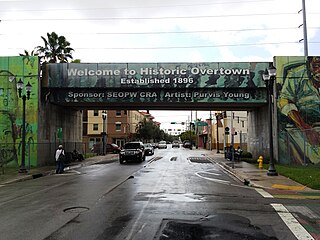
Overtown is a neighborhood of Miami, Florida, United States, just northwest of Downtown Miami. Originally called Colored Town in the Jim Crow era of the late 19th through the mid-20th century, the area was once the preeminent and is the historic center for commerce in the black community in Miami and South Florida.

Pearl City is a historic African American neighborhood, and the oldest community, in Boca Raton, Florida. The establishment of Pearl City predates the official incorporation of Boca Raton. In December 2023, Pearl City was added to National Register of Historic Places by the National Park Service. The neighborhood's name is thought to be derived from the Hawaiian Pearl, a variety of pineapple grown in the Boca Raton area at the time of Pearl City's inception. Pearl City is located directly south of Glades Road between Dixie Highway and Federal Highway in Boca Raton. During segregation, Pearl City developed a rich social, economic and cultural life which persists today.

The Royal Poinciana Hotel was a Gilded Age hotel in Palm Beach, Florida, United States. Developed by Standard Oil founder Henry Flagler and approximately 1,000 workers, the hotel opened on February 11, 1894. As Flagler's first structure in South Florida, the Royal Poinciana Hotel played a significant role in the region's history, transforming the previously desolate area into a winter tourist destination and accelerating the development of Palm Beach and West Palm Beach. Two months later, Flagler's Florida East Coast Railway reached West Palm Beach, while a railroad bridge built across the Lake Worth Lagoon in 1895 allowed guests direct access to the hotel. In 1896, Flagler opened a second hotel nearby, The Breakers. The success of both hotels led to expansions of the Royal Poinciana Hotel in 1899 and 1901. By then, the building had reportedly become both the largest hotel and largest wooden structure in the world at the time.
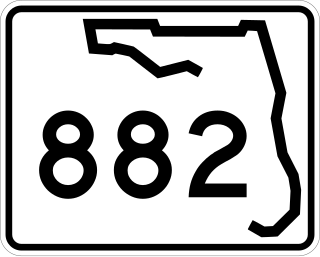
State Road 882 (SR 882), locally known as Forest Hill Boulevard, is a 9.233-mile-long (14.859 km) east–west highway serving central Palm Beach County, Florida. Its western terminus is at an intersection of US 441-SR 7 in Wellington, Florida; and its eastern terminus is at an intersection with South Dixie Highway (U.S.1/SR 805 in West Palm Beach, Florida. SR 882 also serves as a primary commuter road for Greenacres, Palm Springs, Lake Clarke Shores, and West Palm Beach.

The El Cid Historic District is a U.S. historic district located in West Palm Beach, Florida. The district is bounded by Flamingo Drive, South Flagler Drive, Dyer Road and South Dixie Highway. It contains 281 historic buildings.
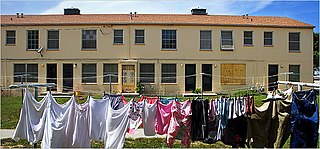
Dunbar Village is a 246-unit public housing community located within the North Tamarind neighborhood of West Palm Beach, Florida. The community is directly east of North Tamarind Avenue, and borders the neighborhoods of Pleasant City and Northwood Pines. It is named after the late 19th- and early 20th-century poet, Paul Laurence Dunbar. The community was built from 1939 to 1940 for African Americans, and is alike to Liberty Square and Edison Courts in Miami for its "army barracks" configuration. Constructed shortly after the passage of the Housing Act of 1937, the community is one of the first public housing in the state of Florida.
Harvey and Clarke was an American architectural firm formed by Henry Stephen Harvey and L. Philips Clarke in West Palm Beach, Florida, in 1921. The firm was active in South Florida for only a few years, but in that time designed a number of distinctive homes, apartments, churches, and commercial buildings. Harvey was a member of the West Palm Beach Planning Commission. An additional Firm member and staff was Gustav Maass, who designed several local railroad stations, and later became a noted South Florida architect in his own right.
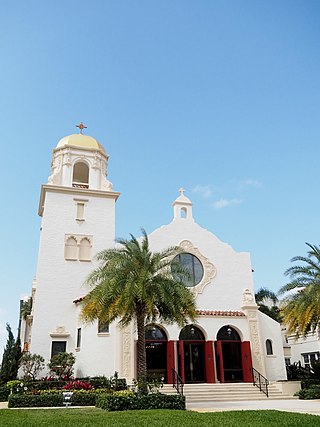
Holy Trinity Episcopal Church is a historic building at 211 Trinity Place in West Palm Beach.
The history of West Palm Beach, Florida, began more than 5,000 years ago with the arrival of the first aboriginal natives. Native American tribes such as the Jaegas inhabited the area. Though control of Florida changed among Spain, England, the United States, and the Confederate States of America, the area remained largely undeveloped until the 20th century. By the 1870s and 1880s, non-Native American settlers had inhabited areas in the vicinity of West Palm Beach and referred to the settlement as "Lake Worth Country". However, the population remained very small until the arrival of Henry Flagler in the 1890s. Flagler constructed hotels and resorts in Palm Beach to create a travel destination for affluent tourists, who could travel there via his railroad beginning in 1894.
Palm Beach County is a county in the southeastern part of the U.S. state of Florida. Its history dates back to about 12,000 years ago, shortly after when Native Americans migrated into Florida. Juan Ponce de León became the first European in the area, landing at the Jupiter Inlet in 1513. Diseases from Europe, enslavement, and warfare significantly diminished the indigenous population of Florida over the next few centuries. During the Second Seminole War, the Battles of the Loxahatchee occurred west of modern-day Jupiter in 1838. The Jupiter Lighthouse, the county's oldest surviving structure, was completed in 1860. The first homestead claims were filed around Lake Worth in 1873. The county's first hotel, schoolhouse, and railway, the Celestial Railroad, began operating in the 1880s, while the first settlers of modern-day Lake Worth Beach arrived in 1885. During the 1890s, Henry Flagler and his workers constructed the Royal Poinciana Hotel and The Breakers in Palm Beach and extended the Florida East Coast Railway southward to the area. They also developed a separate city for hotel workers, which in 1894 became West Palm Beach, the county's oldest incorporated municipality. Major Nathan Boynton, Congressman William S. Linton, and railroad surveyor Thomas Rickards also arrived in the 1890s and developed communities that became Boynton Beach, Delray Beach, and Boca Raton, respectively.

Elisha Newton "Cap" Dimick was an American politician and pioneer of modern-day Palm Beach County, Florida. Born in Michigan in 1849, the Dimick family moved to the area now known as Palm Beach, Florida, in 1876. Dimick built his residence there in the late 1870s, and in 1880, converted it to the Cocoanut Grove House, then the only hotel between Key West and Titusville. He became a politician in the 1890s, serving one term in the Florida House of Representatives and later four terms in the Florida Senate as a member of the Democratic Party. Dimick also co-founded the Lake Worth region's first bank in 1893, the Dade County State Bank, which assisted Henry Flagler in providing compensation to workers constructing the Royal Poinciana Hotel and The Breakers. Today, the bank building is considered the oldest surviving commercial structure in Palm Beach County.

















